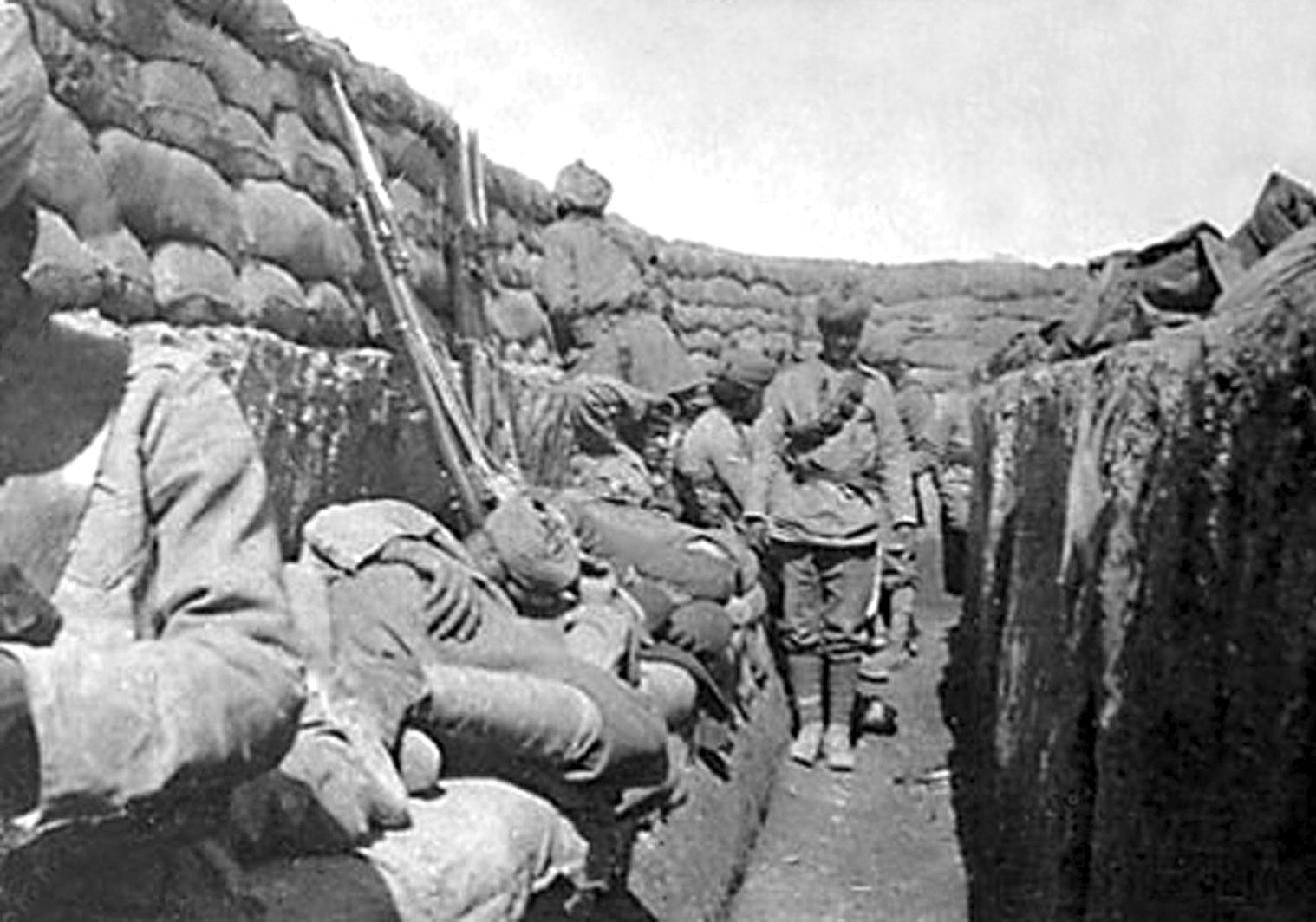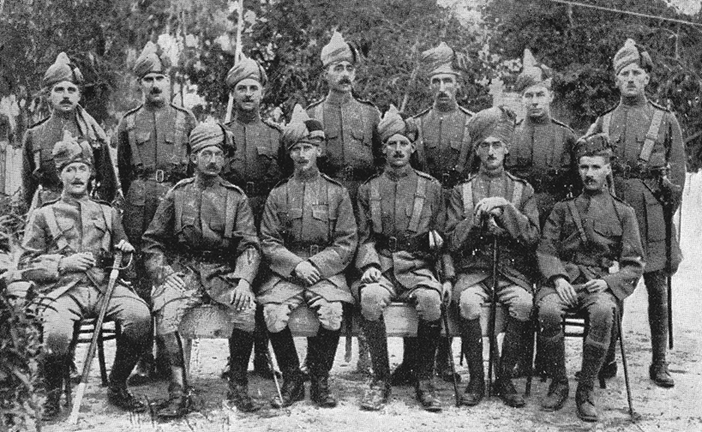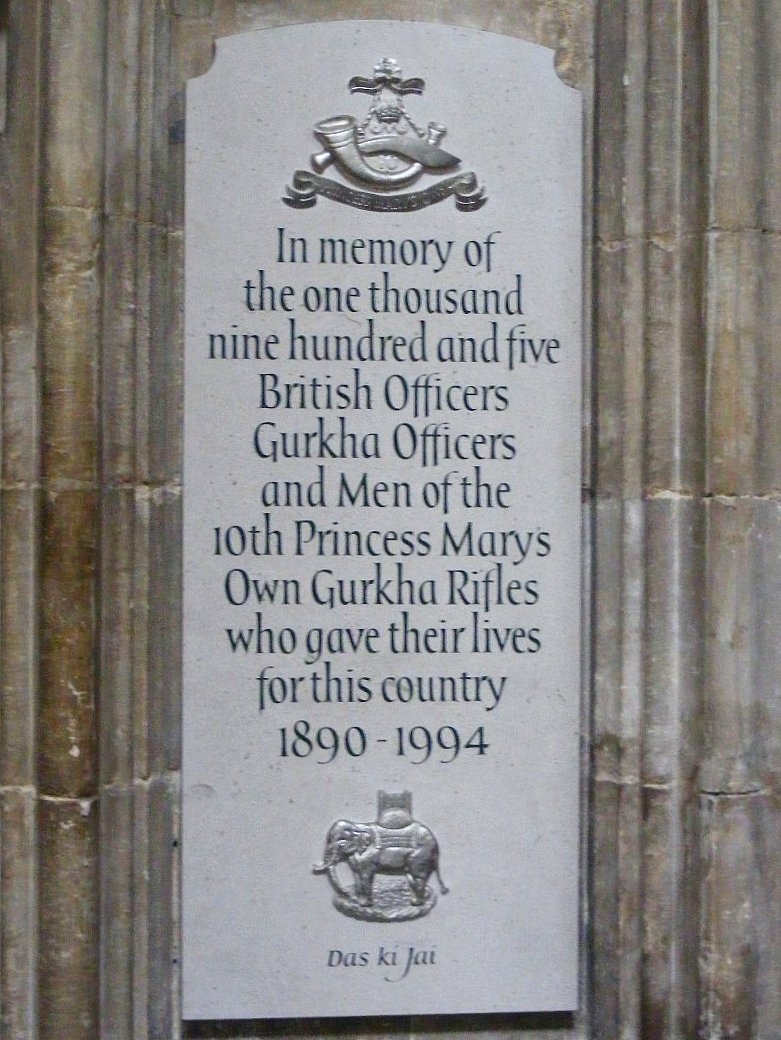|
11th Indian Division
The 11th Indian Division was an infantry Division (military), division of the British Indian Army during World War I. It was formed in December 1914 with two infantry brigades already in Egypt and a third formed in January 1915. After taking part in the Raid on the Suez Canal, Actions on the Suez Canal, the division was dispersed as its brigades were posted away. The division was commanded throughout its existence by Major-General Alexander Wallace. History The pre-war 22nd (Lucknow) Brigade and the 32nd (Imperial Service) Brigade (formed in October 1914) were posted to Egypt to help defend the Suez Canal. The 11th Indian Division was formed on 24 December 1914 with these two brigades, and little else in terms of divisional troops. A third brigade (31st Indian Brigade, 31st) was formed in January 1915 with other units already in Egypt. The division beat off Ottoman Empire, Turkish attempts to cross the Suez Canal on 3–4 February 1915 in the Raid on the Suez Canal, Actions ... [...More Info...] [...Related Items...] OR: [Wikipedia] [Google] [Baidu] |
British Raj
The British Raj (; from Hindi ''rāj'': kingdom, realm, state, or empire) was the rule of the British Crown on the Indian subcontinent; * * it is also called Crown rule in India, * * * * or Direct rule in India, * Quote: "Mill, who was himself employed by the British East India company from the age of seventeen until the British government assumed direct rule over India in 1858." * * and lasted from 1858 to 1947. * * The region under British control was commonly called India in contemporaneous usage and included areas directly administered by the United Kingdom, which were collectively called British India, and areas ruled by indigenous rulers, but under British paramountcy, called the princely states. The region was sometimes called the Indian Empire, though not officially. As ''India'', it was a founding member of the League of Nations, a participating nation in the Summer Olympics in 1900, 1920, 1928, 1932, and 1936, and a founding member of the United Nations in San F ... [...More Info...] [...Related Items...] OR: [Wikipedia] [Google] [Baidu] |
Imperial Service Cavalry Brigade
The 15th (Imperial Service) Cavalry Brigade was a brigade-sized formation that served alongside British Empire forces in the Sinai and Palestine Campaign, during World War I. Originally called the Imperial Service Cavalry Brigade it was formed from Imperial Service Troops provided by the Indian Princely States of Jodhpur, Hyderabad, Mysore, Patiala and Alwar which each provided a regiment of lancers. A maximum of three regiments served in the brigade at any one time. The states of Kashmir, Idar and Kathiawar provided smaller detachments for the brigade, which was at times reinforced by other British Empire regiments and artillery batteries when on operations. In October 1914, the Imperial Service Cavalry Brigade was moved by sea to Egypt to become part of the Force in Egypt defending the Suez Canal. In the first three years of the war, the soldiers were involved in several small-scale battles connected to the First Suez Offensive, but spent most of their time patrolling in the ... [...More Info...] [...Related Items...] OR: [Wikipedia] [Google] [Baidu] |
128th Pioneers
The 128th Pioneers were an infantry regiment of the British Indian Army. The regiment traces their origins to 1846, when they were raised as the 28th Bombay Native Infantry. The regiments first action was in Afghanistan during the Second Afghan War in the Battle of Kandahar. In 1885, they were sent to Egypt to take part in the Sudan Campaign. They played an active part in the Battle of Tofrek and the Battle of Suakin. On their return to India they were part of the force gathered for the Tirah Campaign in 1897. During World War I they were sent to Egypt, to guard the Suez Canal from Turkish forces. They were originally attached to the 10th Indian Division but moved to the 11th Indian Division in 1916. After World War I the Indian government reformed the army moving from single battalion regiments to multi battalion regiments.Sumner p.15 In 1922, the 128th Pioneers became the 3rd Battalion, 2nd Bombay Pioneers. The regiment was disbanded in 1932. William St. Lucien Chase William ... [...More Info...] [...Related Items...] OR: [Wikipedia] [Google] [Baidu] |
93rd Burma Infantry
The 93rd Burma Infantry was an infantry regiment of the British Indian Army. The regiment was raised in 1800 as a battalion of Madras Native Infantry. It was designated as the 93rd Burma Infantry in 1903 and became the 5th (Burma) Battalion 8th Punjab Regiment in 1922. In 1947, it was allocated to the Pakistan Army, where it continues to exist as 5th Battalion of The Baloch Regiment.Ahmad, Lt Col RN. (2010). ''Battle Honours of the Baloch Regiment''. Abbottabad: The Baloch Regimental Centre. Early history The regiment was raised on 1 January 1800 at Guntur, in South India as the 1st Battalion 17th Regiment of Madras Native Infantry by Colonel George Wahab, and was known as ''Wahab ki Paltan'' (Wahab's Battalion). It was composed mostly of Muslims, Tamils and Telugus. In 1803, it took part in the Second Anglo-Maratha War, while in 1809, at Cochin, it repulsed a force of 3000 rebels during the Travancore War. In 1817, the battalion operated against the Pindaris during the Third An ... [...More Info...] [...Related Items...] OR: [Wikipedia] [Google] [Baidu] |
27th Punjabis
The 27th Punjabis were an infantry regiment of the British Indian Army. It was raised in 1857, as the 19th Regiment of Punjab Infantry. It was designated as the 27th Punjabis in 1903 and became 3rd Battalion 15th Punjab Regiment in 1922. In 1947, it was allocated to the Pakistan Army, where it continues to exist as 11th Battalion The Punjab Regiment.Rizvi, Brig SHA. (1984). ''Veteran Campaigners – A History of the Punjab Regiment 1759–1981''. Lahore: Wajidalis. Early history The regiment was raised during the upheaval of the Indian Mutiny, at Rawalpindi on 19 June 1857, as the Regiment of Rawalpindi. In 1860, it was sent to China to fight in the Second Anglo-China War. In 1861, the regiment was permitted to use the Royal Cypher within the Garter on its appointments for its meritorious services. During the Second Afghan War of 1878–80, as part of the Peshawar Valley Field Force, it advanced into the Khyber Pass to clear Afghan forces at Ali Masjid. In 1885, the regiment parti ... [...More Info...] [...Related Items...] OR: [Wikipedia] [Google] [Baidu] |
2nd Queen Victoria's Own Rajput Light Infantry
The 2nd Queen Victoria's Own Rajput Light Infantry, commonly shortened to 2nd Rajputs, was a regiment of the British Indian Army. Raised in 1798, it was amalgamated with five other Rajput regiments in 1922. History The British East India Company raised a 2nd Battalion for the 15th Regiment of Bengal Native Infantry (BNI) in 1798. As such, it fought at Delhi, Laswari, Deeg, and Bharatpur. For its service under General Lake during the Second Anglo-Maratha War, the battalion was granted an honorary colour; an additional jemadar was employed on its strength to carry it. The battalion was separated from the 15th in 1828, to form the 31st Bengal Native Infantry. Its first campaign as a regiment was in 1839, in the First Anglo-Afghan War. The regiment fought at Kalat, a fortress captured on 13 November. Three battle honours were awarded during the Second Anglo-Sikh War, two for the battles of Chillianwala and Gujarat. In the Indian rebellion of 1857, the regiment did not mutiny and ... [...More Info...] [...Related Items...] OR: [Wikipedia] [Google] [Baidu] |
92nd Punjabis
The 92nd Punjabis were an infantry regiment of the British Indian Army. The regiment was raised in 1800 as a battalion of Madras Native Infantry. It was designated as the 92nd Punjabis in 1903 and became 4th Battalion (Prince of Wales's Own) 8th Punjab Regiment in 1922. In 1947, it was allocated to Pakistan Army, where it continues to exist as 4th Battalion of The Baloch Regiment.Ahmad, Lt Col RN. (2010). ''Battle Honours of the Baloch Regiment''. Abbottabad: The Baloch Regimental Centre. Early history The regiment was raised on 1 January 1800 at Madura as the 2nd Battalion 16th Regiment of Madras Native Infantry by Lieutenant Colonel Alexander Dyce and was known as ''Dyce ki Paltan'' (Dyce's Battalion). It was composed mostly of Muslims, Tamils and Telugus. In 1801, it took part in suppressing a rebellion of the Poligars (local feudal chieftains) of Madura and Tinnevelly in South India. In 1809, it took part in the Travancore War and in 1824, it participated in the First Anglo-Bu ... [...More Info...] [...Related Items...] OR: [Wikipedia] [Google] [Baidu] |
62nd Punjabis
The 62nd Punjabis was an infantry regiment of the British Indian Army. It was raised in 1759 as the 3rd Battalion of Coast Sepoys, and formed part of the Madras Army. It was designated as the 62nd Punjabis in 1903 and became 1st Battalion 1st Punjab Regiment in 1922. In 1947, it was allocated to the Pakistan Army, where it continues to exist as 1st battalion, Punjab Regiment. It is the senior-most surviving infantry battalion of the British Indian Army. History Early history The regiment had its antecedents in the old Madras Army of the British East India Company, which was largely responsible for the British conquest of south and central India. It was raised at Madras in September 1759, as the 3rd Battalion of Coast Sepoys from existing companies of sepoys that had been raised a year earlier. The men were mostly enlisted from South India and consisted of Muslims and Hindus. The regiment was actively engaged in the wars against the French, Mysore and the Marathas. Their first ma ... [...More Info...] [...Related Items...] OR: [Wikipedia] [Google] [Baidu] |
3rd Brahmans
The 3rd Brahmans were an infantry regiment of the British Indian Army. They could trace their origins to 1798, when they were the 1st Battalion, 16th Bengal Native Infantry. Over the years they were known by a number of different names. The 32nd Bengal Native Infantry 1824–1861, the 3rd Regiment of Bengal Native Infantry 1861–1885, the 3rd Regiment of Bengal Infantry 1885–1901 and finally after the Kitchener reforms of the Indian Army when the names of the presidencies were dropped; the 3rd Brahmans. Before being disbanded in 1922, they had taken part in the Second Anglo-Afghan War and World War I World War I (28 July 1914 11 November 1918), often abbreviated as WWI, was one of the deadliest global conflicts in history. Belligerents included much of Europe, the Russian Empire, the United States, and the Ottoman Empire, with fightin .... References * British Indian Army infantry regiments Honourable East India Company regiments Military units and ... [...More Info...] [...Related Items...] OR: [Wikipedia] [Google] [Baidu] |
10th Gurkha Rifles
The 10th Princess Mary's Own Gurkha Rifles, (abbreviated to 10 GR), was originally a rifle regiment of the British Indian Army. The regiment was formed in 1890, taking its lineage from a police unit and over the course of its existence it had a number of changes in designation and composition. It took part in a number of campaigns on the Indian frontiers during the 19th and early 20th centuries, before fighting in the First World War, the Third Anglo-Afghan War and the Second World War. Following India's independence in 1947, the regiment was one of four Gurkha regiments to be transferred to the British Army. In the 1960s it was active in the Malayan Emergency and Indonesian Confrontation. It was amalgamated with the other three British Gurkha regiments to form the Royal Gurkha Rifles in 1994. History Early history At the end of the Third Burmese War in 1887, it was decided to withdraw the regular army battalions and replace them with a freshly recruited military police force ... [...More Info...] [...Related Items...] OR: [Wikipedia] [Google] [Baidu] |
8th (Lucknow) Division
The 8th (Lucknow) Division was a formation of the British Indian Army's Northern Army that was first formed as a result of the Kitchener reforms of the Indian Army in 1903. The Division remained in India on internal security duties during World War I, though the 8th (Lucknow) Cavalry Brigade was transferred to the 1st Indian Cavalry Division and served in France on the Western Front, and the 22nd Lucknow Infantry Brigade served as part of the 11th Indian Division in Egypt. Division formation in 1914 8th (Lucknow) Cavalry Brigade :''Commander: Major General Cookson'' *1st King's Dragoon Guards *16th Cavalry * 36th Jacob's Horse * 39th Central India Horse 22nd (Lucknow) Brigade :''Commander: Major General A. Wilson'' *3rd Battalion, Royal Fusiliers *1st Battalion, King's Own Scottish Borderers * 17th Infantry (The Loyal Regiment) *36th Sikhs * 74th Punjabis *U Battery, Royal Horse Artillery *V Brigade, Royal Field Artillery **63rd, 64th and 73rd Batteries Fyzabad Brigade :' ... [...More Info...] [...Related Items...] OR: [Wikipedia] [Google] [Baidu] |
Brigadier-General
Brigadier general or Brigade general is a military rank used in many countries. It is the lowest ranking general officer in some countries. The rank is usually above a colonel, and below a major general or divisional general. When appointed to a field command, a brigadier general is typically in command of a brigade consisting of around 4,000 troops (four battalions). Variants Brigadier general Brigadier general (Brig. Gen.) is a military rank used in many countries. It is the lowest ranking general officer in some countries, usually sitting between the ranks of colonel and major general. When appointed to a field command, a brigadier general is typically in command of a brigade consisting of around 4,000 troops (four battalions). In some countries, this rank is given the name of ''brigadier'', which is usually equivalent to ''brigadier general'' in the armies of nations that use the rank. The rank can be traced back to the militaries of Europe where a "brigadier general ... [...More Info...] [...Related Items...] OR: [Wikipedia] [Google] [Baidu] |


.jpg)



